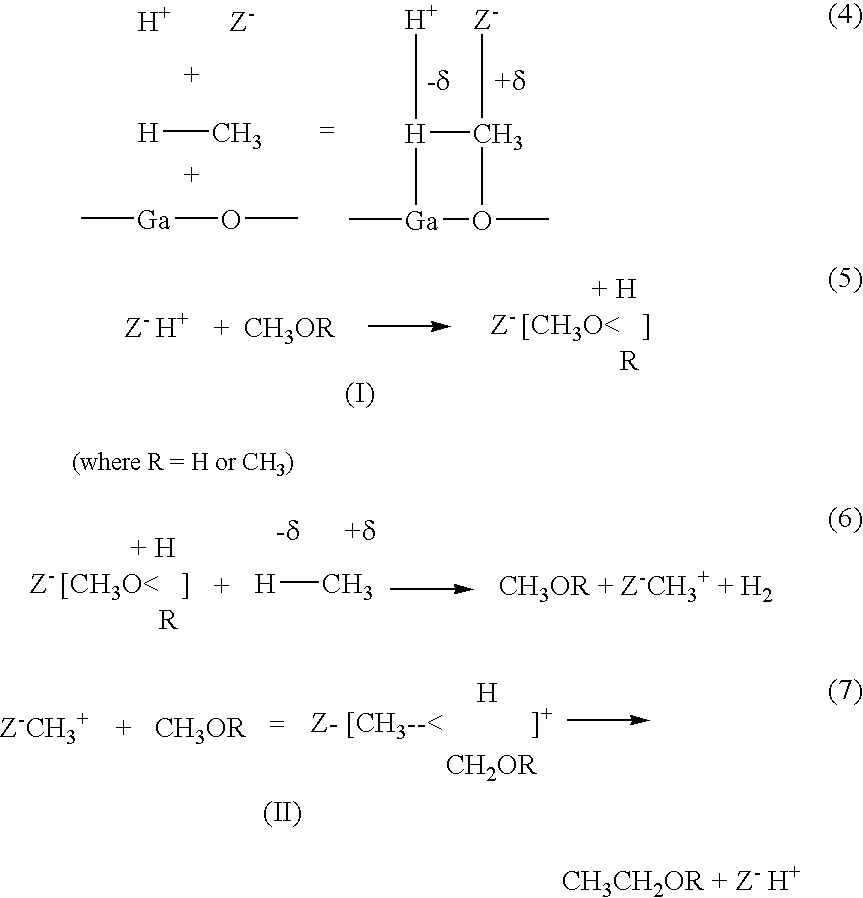Process for the simultaneous conversion of methane and organic oxygenate to C2 to C10 hydrocarbons
a technology of organic oxygenate and methane, which is applied in the field of process, can solve the problems of high process risk, high cost, and high cost of process equipment, and achieve the effect of reducing the cost of production
- Summary
- Abstract
- Description
- Claims
- Application Information
AI Technical Summary
Benefits of technology
Problems solved by technology
Method used
Image
Examples
example 1
[0063]This example illustrates the catalytic process of the present invention for the low temperature non-oxidative conversion of methane and thereby converting it directly to higher hydrocarbons or aromatics using methanol as an additive in the feed comprising methane, and using ZSM-5 type H-galloaluminosilicate zeolite having bulk Si / Ga=24.3, bulk Si / Al=40.3, framework Si / Ga=49.9, framework Si / Al=40.3, Na / (Al+Ga)=0.03, non-framework Ga=0.32 mmol g−1, crystal morphology or shape=spherical-hexagonal, crystal size=5.5±1.5 μm and strong acid sites measured in terms of pyridine chemisorbed at 400° C.=0.46 mmol g−1. All the ratio are mole ratios. The zeolite was prepared by process described in European Patent Application EP 0124271 and in the reference: Choudhary et. al. J. Catal. 158 (1996) 23.
[0064]A conventional tubular quartz reactor of 12 mm internal diameter packed with the zeolite catalyst of 30–52 mesh size particles and kept in the tubular electrical furnace such that the cata...
examples — 2 to 9
EXAMPLES—2 to 9
[0067]These examples illustrate the influence of process conditions, such as methane / methanol mole ratio in the feed, reaction temperature and gas hourly space velocity, GHSV, on the conversion of methane and methanol present in the feed and also on the methane converted per mole of methanol converted in the process of this invention. The catalytic process of this invention was carried out by the reactor and procedures described in EXAMPLE-1 and using the catalyst of Example-1, at the different process conditions, given in Tables 2 and 3. The results are presented in Tables 2 and 3.
[0068]
TABLE 2Results of the simultaneous conversion of methane and methanolover the catalyst of Example 1 at different process conditionsExample No.2345Catalyst usedCatalyst ofCatalyst ofCatalyst ofCatalyst ofExample 1Example 1Example 1Example 1Organic oxygenate usedReaction conditionsMethanolMethanolMethanolMethanolMethane / methanol mole23.824.011.96.8ratio in feedN2 / methane mole ratio in0....
examples — 10 to 13
EXAMPLES—10 to 13
[0070]These examples illustrates the use of the ethanol instead of methanol as an organic oxygenate additive to the feed comprising methane in the process of this invention.
[0071]The catalytic process of this invention was carried out by the procedure described in the EXAMPLE-1 and using the same catalyst and reactor described in EXAMPLE-1, except at ethanol is used instead of methanol and process conditions are different, as given in Table 4. The results are presented in Table 4.
[0072]
TABLE 4Results of the simultaneous conversion of methane and ethanolover the catalyst of Example 1 at different process conditionsExample No.10111213Catalyst usedCatalyst ofCatalyst ofCatalyst ofCatalyst ofExample 1Example 1Example 1Example 1Organic oxygenate usedReaction conditionsEthanolEthanolEthanolEthanolMethane / ethanol mole9.89.79.89.6ratio in feedN2 / methane mole ratio in0.0820.0840.0830.081feedGHSV (cm3g−1h−1)1040104010401080Temperature (° C.)615480580560Pressure (atm.)1.31.31....
PUM
| Property | Measurement | Unit |
|---|---|---|
| mole ratio | aaaaa | aaaaa |
| pressure | aaaaa | aaaaa |
| temperature | aaaaa | aaaaa |
Abstract
Description
Claims
Application Information
 Login to View More
Login to View More - R&D
- Intellectual Property
- Life Sciences
- Materials
- Tech Scout
- Unparalleled Data Quality
- Higher Quality Content
- 60% Fewer Hallucinations
Browse by: Latest US Patents, China's latest patents, Technical Efficacy Thesaurus, Application Domain, Technology Topic, Popular Technical Reports.
© 2025 PatSnap. All rights reserved.Legal|Privacy policy|Modern Slavery Act Transparency Statement|Sitemap|About US| Contact US: help@patsnap.com

